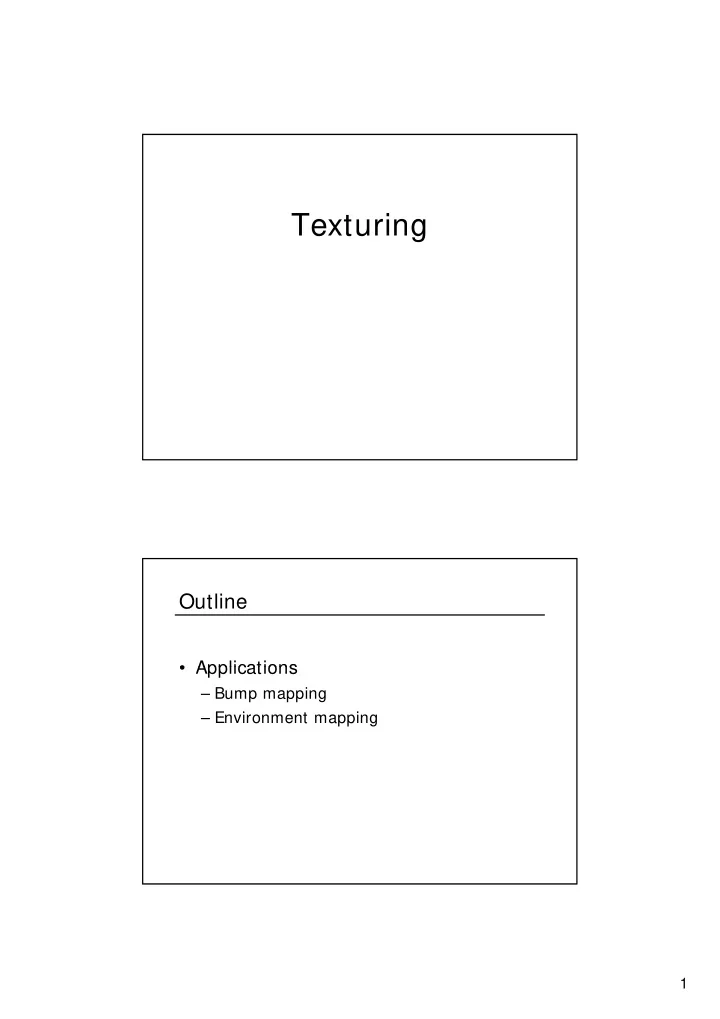

Texturing Outline • Applications • Applications – Bump mapping – Environment mapping 1
Bump Mapping • So far we’ve been thinking of textures modulating color only modulating color only – Decal – Lightmap • But any other per-pixel properties are fair game... • Pixel normals usually smoothly varying – Computed at vertices for Gouraud shading; color Computed at vertices for Gouraud shading; color interpolated – Interpolated from vertices for Phong shading • Textures allow setting per-pixel normal with a bump map Bump mapping: Why? • Can get a lot more surface detail without expense of more object vertices without expense of more object vertices to light, transform courtesy of Nvidia 2
Bump Mapping: How? • Idea: Perturb pixel normals n (u, v) derived from object geometry to get additional detail for shading • Compute lighting per pixel (like Phong) from Hill Bump mapping: Representations • 3-D vector m (u, v) • 3 D vector m (u v) added directly to normal n • Or: 2-D vector of coefficients (b coefficients (b u , b v ) b ) that scale u , v vectors tangent to surface from Akenine-Moller & Haines 3
Bump representation: Height map f(u, v) • Store scalar “altitude” at each pixel • Get b u , b v from partial derivatives: from Akenine-Moller & Haines Example: Converting height maps to normal displacements courtesy of Nvidia Z coordinate set to some constant scale factor; (X, Y) normalized to [0, 1] range. Right image is mostly blue because “straight up” vector is (0, 0, 1) 4
Bump mapping: Example + = from MIT CG lecture notes Bump mapping: Example courtesy of A. Awadallah Height map Bump texture applied to teapot 5
Environment/Reflection Mapping • Problem: To render pixel on mirrored surface correctly, we need to follow reflection of eye vector back to first y intersection with another surface and get its color • This is an expensive procedure • Idea: Approximate with texture mapping from Angel Projecting in non-standard directions • Don’t have to project ray from object center through position (x, y, z) —can use any attribute of that ( , y, ) p y position. For example: – Ray comes from another location – Ray is surface normal n at (x, y, z) – Ray is reflection-from-eye vector r at (x, y, z) – Etc. courtesy of R. Wolfe 6
Projecting in non-standard directions • This can lead to interesting or informative effects ff t courtesy of R. Wolfe Different ray directions for a spherical projector Environment mapping: Details • Key idea: Render 360 degree view of environment from center of object with sphere or box as from center of object with sphere or box as intermediate surface • Intersection of eye reflection vector with intermediate surface provides texture coordinates for reflection/environment mapping courtesy of R. Wolfe 7
Making environment textures: Cube • Cube map straightforward to make: Render/ photograph six rotated views of environment – 4 side views at compass 4 side views at compass points – 1 straight-up view, 1 straight-down view Making environment textures: Sphere • Most often constructed with two photographs of mirrored sphere taken 90 degrees apart courtesy of P. Debevec 8
Environment mapping: Issues • Not physically correct to the extent that object shape differs from intermediate bj t h diff f i t di t surface shape • Looks better when environment objects are farther from object v from Angel Environment mapping: Example courtesy of G. Miller 9
Environment mapping: Example From “Terminator II” 10
Recommend
More recommend